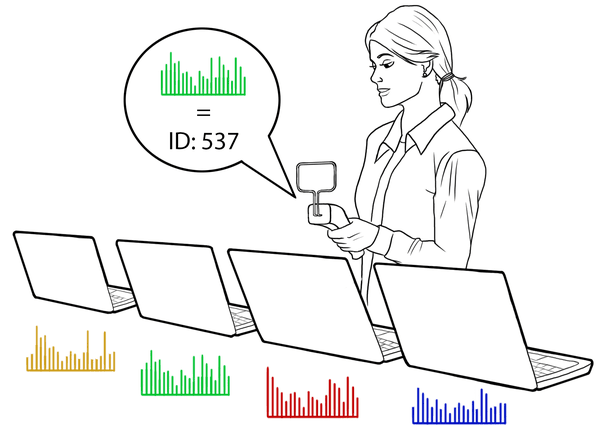Researchers Propose Efficient Alternative To Distinguish Between Identical Electronic Devices
Forensic science depends on unique fingerprint patterns or genetic material to identify an individual with 100% certainty. Analogously, ubiquitous electromagnetic radio waves that emanate from almost all laptops are about to be used to separate one product from another, even when striking similarities exist. Scientists at Disney research have unequivocally put forward a discovery that modifies system noise to work in favour of the distinct goods detection methodology.
Owing to scientific advances, industry based high-statured business groups rely on the Radio Frequency Identification Technology to track inventory. However, due to its expensive status, companies compromise the deal and use a printed bar code as a viable alternative. The latest research from the team succeeded in significantly reducing the cost by adapting to a new method where omnipresent EM waves have been pulled out and coupled with a ranking algorithm which results in a system that can differentiate corresponding products with highest accuracy.

In their last work, a team led by Chouchang Yang and Alanson P. Sample concluded that the generated EM waves are enough to segregate electronic products such as portable gadgets, power tools, computers, household appliances and more. The current innovation, being one step ahead, proved that by adopting a similar approach, their research output could distinguish among the same category.
The leader of Disney Research's Wireless Systems group has mentioned that the system is not foolproof, owing to the statistical dependency of the system. He explained that since it was not assigned to be a unique ID, errorless accuracy could lead to overlapping of EM wave maps, which is theoretically possible. When tested, scientists recorded that the accuracy range pointed to 95%, where iPhone6 could be determined with 72% accuracy and light saber toys with 100% accuracy.
Although the team notified that their research objective was not completely error free, they intentionally provided an algorithm that successfully predicts the success rate. Talking about the process, the system uses a low-cost software-defined radio which is sent to a host computer to remove low-magnitude EM noise.
The remaining peaks, ranging between 1,000 and 2,000 elements, is channelized to first classify and then sub-categorise each one. The second step emerged as a challenge as the frequency distribution overlaps with one another, resulting in the team to consider both frequency and magnitude. The complete report was published yesterday during the IEEE International Conference on RFID, 2016 in Orlando.
Source: #-Link-Snipped-#
Owing to scientific advances, industry based high-statured business groups rely on the Radio Frequency Identification Technology to track inventory. However, due to its expensive status, companies compromise the deal and use a printed bar code as a viable alternative. The latest research from the team succeeded in significantly reducing the cost by adapting to a new method where omnipresent EM waves have been pulled out and coupled with a ranking algorithm which results in a system that can differentiate corresponding products with highest accuracy.

In their last work, a team led by Chouchang Yang and Alanson P. Sample concluded that the generated EM waves are enough to segregate electronic products such as portable gadgets, power tools, computers, household appliances and more. The current innovation, being one step ahead, proved that by adopting a similar approach, their research output could distinguish among the same category.
The leader of Disney Research's Wireless Systems group has mentioned that the system is not foolproof, owing to the statistical dependency of the system. He explained that since it was not assigned to be a unique ID, errorless accuracy could lead to overlapping of EM wave maps, which is theoretically possible. When tested, scientists recorded that the accuracy range pointed to 95%, where iPhone6 could be determined with 72% accuracy and light saber toys with 100% accuracy.
Although the team notified that their research objective was not completely error free, they intentionally provided an algorithm that successfully predicts the success rate. Talking about the process, the system uses a low-cost software-defined radio which is sent to a host computer to remove low-magnitude EM noise.
The remaining peaks, ranging between 1,000 and 2,000 elements, is channelized to first classify and then sub-categorise each one. The second step emerged as a challenge as the frequency distribution overlaps with one another, resulting in the team to consider both frequency and magnitude. The complete report was published yesterday during the IEEE International Conference on RFID, 2016 in Orlando.
Source: #-Link-Snipped-#
0
